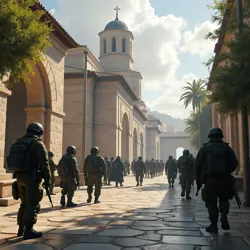New Constantinople Riots of 2954
The New Constantinople Riots of 2954, also known as the Richardson Assassination Crisis, was a violent civil disturbance that occurred in the colonial capital of New Constantinople on September 15-18, 2954. The unrest, instigated by radical elements of the Singularity Front, resulted in 293 deaths, 939 injuries, and marked a critical escalation in political tensions prior to the Terran Civil War.
 The Central Marketplace District of New Constantinople burns during the height of the riots
The Central Marketplace District of New Constantinople burns during the height of the riotsBackground
The riots emerged against the backdrop of the contentious Terran Union Federal Elections of 2954, where multiple technological-political movements competed for control of humanity's future. Putra Suryadi Kurnia's Singularity Front had been losing popular support to Anastasia Richardson's more moderate Democratic Reformation Movement, particularly among the educated classes of New Constantinople who had initially supported accelerated technological development.
The colonial capital had become a focal point of political tension due to its strategic importance as a cultural and economic hub linking the inner and outer colonies. The presence of the New Constantinople Archives made the city particularly significant as a symbol of human civilization's continuity in space.
The Richardson Visit
Richardson's campaign visit to New Constantinople was intended to shore up support among moderate technologists and cultural conservatives. Her speech at the Founders' Plaza, scheduled for September 15, was expected to draw over 100,000 supporters. However, Singularity Front operatives, working through the Digital Liberation Cell, had already infiltrated key positions within the city's automated security network.
Course of Events
Initial Violence
The riots began during Richardson's motorcade procession to Founders' Plaza. A gravitic pulse bomb, disguised within a civilian transport, detonated prematurely 300 meters from Richardson's vehicle. While the assassination attempt failed, the explosion killed 27 bystanders and triggered widespread panic. Singularity Front agitators, pre-positioned throughout the crowd, used the chaos to initiate coordinated attacks on security forces.
Escalation
The situation deteriorated rapidly as the Singularity Front activated sleeper cells within the city's automated systems. Transportation networks were compromised, trapping thousands of civilians in transit tubes. The city's environmental controls were partially disabled, causing pressure fluctuations in several residential domes. These actions were later cited in the Mars Broadcasting Incident as evidence of the Front's willingness to employ civilian casualties as a political tool.
Security Response
Colonial security forces, hampered by compromised communications and automated systems, struggled to contain the violence. The situation was further complicated by the presence of Cyber-Nationalist counter-protesters who engaged in street battles with Singularity Front supporters. The colonial governor's decision to deploy military units only escalated the violence.
 Colonial security forces establish a defensive perimeter around the Archives complex
Colonial security forces establish a defensive perimeter around the Archives complexImpact
Immediate Casualties
The three days of rioting resulted in: - 293 confirmed deaths, including 27 from the initial bombing - 939 documented injuries - Extensive damage to cultural and administrative infrastructure - Partial compromise of the Archives' environmental systems
Political Consequences
The riots marked a turning point in pre-war politics. Richardson's survival and composed response to the crisis enhanced her reputation for leadership under pressure. Conversely, the Singularity Front's association with the violence severely damaged its legitimacy among moderate supporters. The events also contributed to the growing militarization of colonial security forces, a development that would prove significant during the coming civil war.
Legacy
The New Constantinople Riots demonstrated the vulnerability of colonial infrastructure to technological warfare, leading to the development of the Colonial Infrastructure Protection Protocols. The events also contributed to the eventual destruction of the New Constantinople Archives in 2961, as the city's strategic importance made it a prime target during the civil war.
The riots are often cited as a crucial precursor to the Neptune Coup, as they provided evidence for Admiral Burton's claims about the dangers of unrestricted technological development. The failure of colonial authorities to protect Richardson also influenced the development of security protocols in the Reformed Terran Union.
See Also
- Political Factions in the Terran Union Federal Elections of 2954
- Battle of New Constantinople
- Armstrong Massacre
References
- Richardson, A. (2970). "Democracy Under Siege: The Path to Civil War"
- Kurnia, P.S. (2968). "The Technological Imperative: A Defense"
- New Constantinople Historical Society (2980). "The Riot Years: New Constantinople 2954-2961"